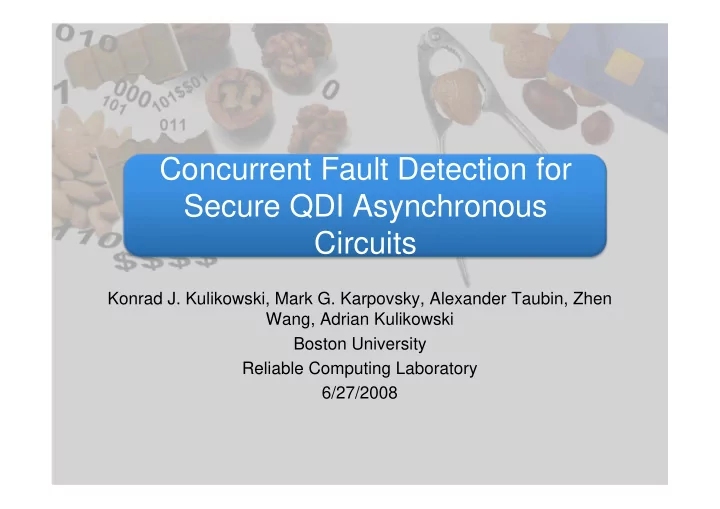

Concurrent Fault Detection for Secure QDI Asynchronous Circuits Konrad J. Kulikowski, Mark G. Karpovsky, Alexander Taubin, Zhen Wang, Adrian Kulikowski Boston University Reliable Computing Laboratory 6/27/2008
Outline •Side Channel Attacks •Asynchronous nanocircuits for security •Faults in asynchronous fine grained pipelines •Robust Codes •Basic properties and design purpose •Minimum distance robust codes •Application to AES •Fault Simulation 2 Konrad J. Kulikowski
Side Channel Attacks Faults EM timing Faulty power cipher 3 Konrad J. Kulikowski
Nanocircuits and Async in Security Nanocircuits Asynchronous QDI •Lower signal to noise ratio •Clockless designs have been •Harder to probe or reverse shown to have natural benefits engineer against power and EMI attacks •Higher variability allows • Tolerant to variability design of novel features like • Natural fault tolerance physically unclonable functions (PUF) •Higher fault rates •Higher variability 4 Konrad J. Kulikowski
Faults in Asynchronous QDI Design 1.Deadlock 2.Invalid data token (‘11’) 3.Data modification (flipping a value of a data token) 4.Data generation (creation of a data token) 5.Data deletion (deletion of a data token) 5 Konrad J. Kulikowski
Data Insertion/Deletion 6 Konrad J. Kulikowski
Data Creation/Deletion Main Characteristics •A single transient fault can create a stream of erroneous data •Error at output can repeat indefinitely Solution Criteria •Detect token insertions, not just prevent the effect •Detection allows reaction/prevention to an attack •Concurrent error detection using error control codes •Detect all possible token insertions •Reduce the worst detection probability Can we exploit the repeating nature of errors to improve error detection? 7 Konrad J. Kulikowski
Robust Error Detecting Codes •Nonlinear •ALL errors are detectable with a high probability •Provide a guaranteed level of protection for all errors 8 Konrad J. Kulikowski
Error Detecting Codes 2 n w+e1 C w w+e2 •Linear codes have |C| errors which are undetectable •Repeating errors do not improve error detection 9 Konrad J. Kulikowski
Robust Error Detecting Codes 2 n n , (2 ) C � e � � e GF C = < max | ( ) | | | � � R C C e C Every error is missed for at most R messages (max Q(e)=R/|C|) Detection probability increases as more erroneous messages are observed 10 Konrad J. Kulikowski
Systematic Robust Codes f(x) “highly nonlinear function” optimum when f(x) is a “perfect nonlinear function” (k+1,k,1) code with R=2 k-1 11 Konrad J. Kulikowski
Minimum Distance Robust Codes {(x,p(x)) } is a linear code with distance d f(x) is a perfect nonlinear function p(x) parity (k+2,k,2) code with R=2 k-1 12 Konrad J. Kulikowski
Application to Asynchronous AES M. Karpovsky, K. J. Kulikowski, and A. Taubin. “Differential Fault Analysis Attack Resistant Architectures for the Advanced Encryption Standard”. In CARDIS, 2004. 13 Konrad J. Kulikowski
Concurrent Error Detection Linear parity: 35% (x,p(x) ) Robust: 100% (x,f(x) ) Robust and parity: 120% (x,p(x),f(x) ) 14 Konrad J. Kulikowski
Evaluation Random Inputs Faults causing single token creations/deletion s How long does it take to detect the erroneous behavior? 15 Konrad J. Kulikowski
Histogram of Manifestations Synthesized using Desing Compiler 216 two input XOR gates Multiplicity of Errors resulting from single faults •27% of errors are even •Many Errors are of a high multiplicity 16 Konrad J. Kulikowski
Simulation Results 27% of token creations/deletions missed 17 Konrad J. Kulikowski
Summary • Token creation/deletion can lead to a long stream of erroneous data • Repeating nature of the errors can be used to enhance the error detection • Beneficial for security • Detect other failures (data modification) • Adds another level of security 18 Konrad J. Kulikowski
Recommend
More recommend